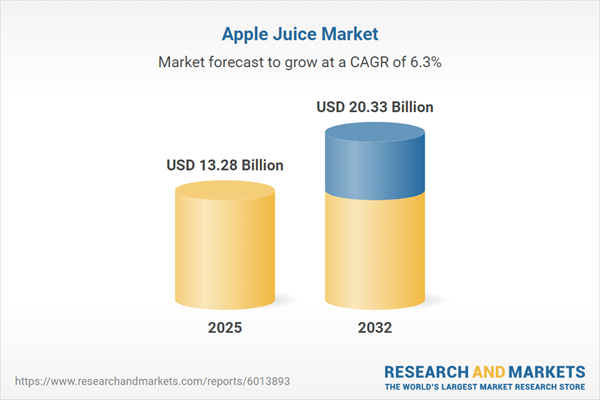Speak directly to the analyst to clarify any post sales queries you may have.
The apple juice market is undergoing significant transformation, driven by evolving technological innovations, changing consumer preferences, and dynamic international trade developments. Senior decision-makers navigating the beverage sector require actionable insights that reveal both current dynamics and future growth avenues in this competitive landscape.
Market Snapshot: Growth and Outlook for the Apple Juice Industry
The Apple Juice Market grew from USD 12.48 billion in 2024 to USD 13.28 billion in 2025. It is expected to continue growing at a CAGR of 6.28%, reaching USD 20.33 billion by 2032. This sustained expansion is supported by shifts in consumer demand, rapid advancements in processing technology, and ongoing evolution in regional supply chains. The sector’s resilience is evident in its capacity to adapt both in production methodologies and market reach.
Scope & Segmentation: Comprehensive Market Coverage
- End Use: Foodservice and household segments, each with unique requirements regarding package size, convenience, and delivery models.
- Product Grade: Includes both conventional and organic offerings, serving distinct consumer bases with different purchasing priorities.
- Product Flavor: Single-flavor and blended apple juice options formulated for diverse consumption occasions and taste profiles.
- Source: Both from concentrate and not-from-concentrate products, reflecting differences in production investment and product positioning.
- Distribution Channel: Convenience stores, online retail, and supermarkets, each with specialized strategies for market penetration and consumer engagement.
- Packaging Type: Cartons, glass bottles, PET bottles, spouted pouches, and stand-up pouches, addressing factors such as branding, sustainability, and shelf stability.
- Regions: Americas (including North and Latin America), Europe, Middle East & Africa, and Asia-Pacific, each displaying unique market drivers and infrastructure characteristics.
- Leading Companies: The Coca-Cola Company, PepsiCo, Inc., Keurig Dr Pepper Inc., Fresh Del Monte Produce Inc., Welch Foods Inc., Ocean Spray Cranberries, Inc., Tree Top, Inc., S. Martinelli & Co., Eckes-Granini Group GmbH, Royal Wessanen N.V.
Key Takeaways: Strategic Insights for Decision-Makers
- Advancements such as cold-pressed extraction and novel preservation methods are enhancing product quality and extending shelf life across production lines.
- There is notable growth in organic and minimally processed apple juice, appealing to health-conscious consumers and premium retail channels.
- Digital transformation supports omnichannel retail strategies, enabling brands to capture direct-to-consumer sales and nurture loyalty.
- Supply chain adaptability is increasingly critical, prompting investment in traceability, diversified sourcing, and closer relationships with growers embracing regenerative agriculture.
- Premiumization is fueling diversification, introducing specialty blends and single-origin juices for new culinary and mixology applications.
- Collaborative frameworks with logistics partners and technology innovators are enabling agile responses to fluctuations in demand and supply conditions.
Tariff Impact: Navigating Regulatory and Trade Shifts
New United States tariffs applied in 2025 have reshaped the apple juice supply chain and pricing strategies by altering import costs for both concentrated and finished goods. International suppliers are exploring alternative markets and renegotiating logistics contracts to manage increased expenses. Some producers are investing in domestic processing facilities to minimize tariff exposure, while collaborations between growers and bottlers now include flexible pricing terms. Stakeholders are actively engaging in industry advocacy to shape future regulatory outcomes, recognizing that ongoing policy changes influence long-term supply chain decisions.
Methodology & Data Sources
This report integrates secondary research from publications, regulatory filings, and trade associations with primary interviews of executives and technical specialists. Diverse datasets are triangulated for accuracy, and findings are interpreted through industry-relevant frameworks such as PESTEL, SWOT, and Porter’s Five Forces. Internal peer reviews and methodological audits ensure consistency and reliability throughout the analysis.
Why This Report Matters
- Enables leaders to make data-driven decisions by uncovering segment trends and anticipating disruptive regulatory events.
- Offers benchmarks and best practices for optimizing product portfolios, supply chains, and distribution strategies.
- Highlights actionable opportunities in untapped regional markets and emerging product categories.
Conclusion
The apple juice sector’s competitive landscape continues to evolve, shaped by changing consumer demands, technological advancements, and regulatory developments. Informed strategic planning will enable stakeholders to adapt, innovate, and drive sustained growth in a complex global market.
Additional Product Information:
- Purchase of this report includes 1 year online access with quarterly updates.
- This report can be updated on request. Please contact our Customer Experience team using the Ask a Question widget on our website.
Table of Contents
3. Executive Summary
4. Market Overview
7. Cumulative Impact of Artificial Intelligence 2025
Companies Mentioned
The companies profiled in this Apple Juice market report include:- The Coca-Cola Company
- PepsiCo, Inc.
- Keurig Dr Pepper Inc.
- Fresh Del Monte Produce Inc.
- Welch Foods Inc.
- Ocean Spray Cranberries, Inc.
- Tree Top, Inc.
- S. Martinelli & Co.
- Eckes-Granini Group GmbH
- Royal Wessanen N.V.
Table Information
| Report Attribute | Details |
|---|---|
| No. of Pages | 195 |
| Published | October 2025 |
| Forecast Period | 2025 - 2032 |
| Estimated Market Value ( USD | $ 13.28 Billion |
| Forecasted Market Value ( USD | $ 20.33 Billion |
| Compound Annual Growth Rate | 6.2% |
| Regions Covered | Global |
| No. of Companies Mentioned | 11 |









